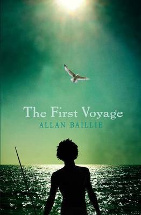The first voyage by Allan Baillie

Puffin, 2014. ISBN 9780143307679.
Set in the Stone Age, this novel considers how ancient people were
able to migrate to the land mass referred to as Sahul (comprising
Australia and New Guinea), the coastlines of which extended much
further and which have significantly altered with the passing of the
Ice Age.
In Timor, the violently aggressive Crocodile tribe seek to drive the
small Yam tribe from the island by opportunistically killing members
and trying to provoke battles. Left with nowhere to run and hide,
the Yam tribe is doomed unless new territory is discovered and the
leader, Eagle Eye chooses to follow migrating birds to a new land.
The tribe must find materials and learn how to build and provision
rafts for what would have been a terrifying voyage into the unknown.
Told from the perspective of young adolescent warrior Bent Beak, the
story cleverly mirrors the experience of present day refugees who
are prepared to risk their own and their children's lives on a
perilous journey in order to escape violence and death.
Bailey has a considerable freedom to imagine the circumstances and
actions of these ancient people and he writes with a great deal of
humanity, prompting the reader to deeply consider the plight of
desperate people. The nature of leadership is revealed, with Eagle
Eye having almost no power to change anything whilst saddled with
the responsibility of choosing the best outcome for his
people. Ingenuity, group cooperation, roles and relationships
are features of this tale which helps us to visualise the enormous
task faced by those who came to inhabit our land.
This is a good book for young teenagers yet many will struggle to
understand the massive geographical change which made the journey
possible. The book's blurb is confusing, stating that it is set
30,000 years ago which does not seem to match the setting or title
given the existence of Homo Sapiens in Australia for a minimum
40,000 years. However the 'first voyage' may refer to people
venturing from this particular region. Similarly some readers may
not comprehend the author's depiction of megafauna including a
diprotodon which does not fit the era. The novel would have
benefitted from a comprehensive foreword with better diagrams and
information than are provided in the brief postscript. This
may help young readers to visualise the arrival of ancient ancestors
from various regions, joining others already here, by means of
island hopping taking place over a huge time scale.
Rob Welsh